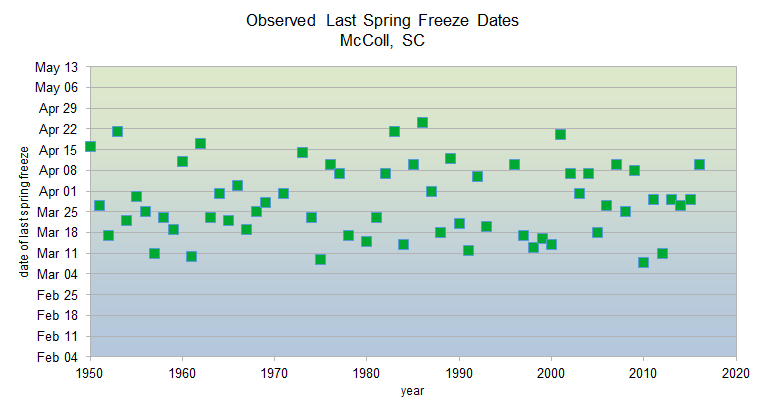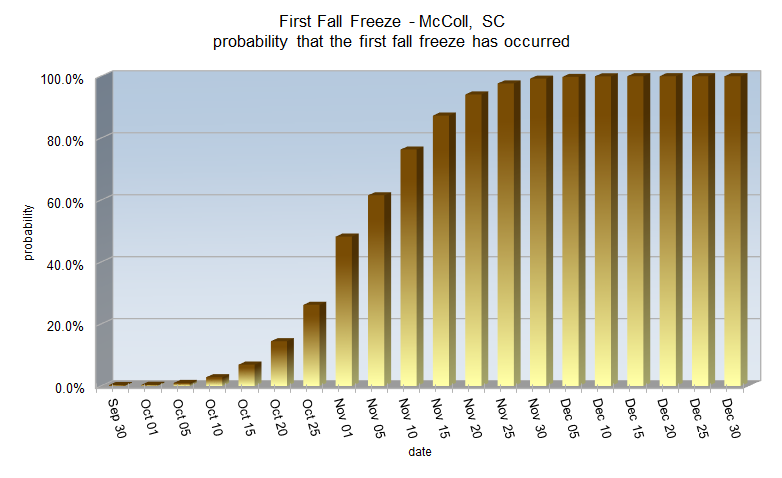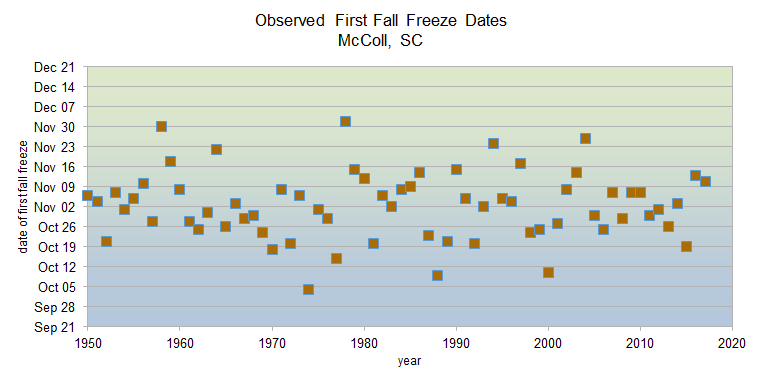McColl, South Carolina Spring and Fall Freeze Statistics
|
McColl's average date for the last spring freeze is March 28
Spring freeze statistics sorted by probability
| Probability |
Date |
| 1% |
Feb 27 |
| 5% |
Mar 8 |
| 10% |
Mar 12 |
| 25% |
Mar 20 |
| 50% |
Mar 28 |
| 75% |
Apr 5 |
| 90% |
Apr 13 |
| 95% |
Apr 17 |
| 99% |
Apr 26 |
Earliest last spring freeze: Feb 25, 1946
Latest last spring freeze: April 24, 1986
|
Spring freeze statistics sorted by date
| Date |
Probability |
| Jan 25 |
0.0% |
| Feb 1 |
0.0% |
| Feb 5 |
0.0% |
| Feb 10 |
0.0% |
| Feb 15 |
0.0% |
| Feb 20 |
0.2% |
| Feb 25 |
0.5% |
| Mar 1 |
1.3% |
| Mar 5 |
2.9% |
| Mar 10 |
6.8% |
| Mar 15 |
13.9% |
| Mar 20 |
24.8% |
| Mar 25 |
39.2% |
| Mar 30 |
55.2% |
| Apr 5 |
73.1% |
| Apr 10 |
84.7% |
| Apr 15 |
92.3% |
| Apr 20 |
96.7% |
| Apr 25 |
98.7% |
| Apr 30 |
99.6% |
| May 5 |
99.9% |
| May 10 |
100.0% |
|


Since 1950, McColl has 9 years of missing climate data. This makes it difficult to determine a statistically accurate change in spring freeze dates.
|
|
McColl's average date for the first fall freeze is November 1
Fall freeze statistics sorted by probability
| Probability |
Date |
| 1% |
Oct 5 |
| 5% |
Oct 13 |
| 10% |
Oct 17 |
| 25% |
Oct 25 |
| 50% |
Nov 1 |
| 75% |
Nov 9 |
| 90% |
Nov 16 |
| 95% |
Nov 20 |
| 99% |
Nov 29 |
Earliest first fall freeze: October 4, 1974
Latest first fall freeze: December 2, 1978
|
Fall freeze statistics sorted by date
| Date |
Probability |
| Oct 1 |
0.4% |
| Oct 5 |
1.0% |
| Oct 10 |
2.8% |
| Oct 15 |
6.9% |
| Oct 20 |
14.5% |
| Oct 25 |
26.2% |
| Nov 1 |
48.2% |
| Nov 5 |
61.6% |
| Nov 10 |
76.3% |
| Nov 15 |
87.3% |
| Nov 20 |
94.1% |
| Nov 25 |
97.6% |
| Nov 30 |
99.2% |
| Dec 5 |
99.8% |
| Dec 10 |
99.9% |
| Dec 15 |
100.0% |
| Dec 20 |
100.0% |
| Dec 25 |
100.0% |
| Dec 30 |
99.7% |
|


Since 1950, McColl has 9 years of missing climate data. This makes it difficult to determine a statistically accurate change in fall freeze dates.
|
|
McColl's average growing season length is 217 days
Growing season statistics sorted by probability
| Probability |
Days |
| 1% |
254 |
| 5% |
243 |
| 10% |
237 |
| 25% |
228 |
| 50% |
217 |
| 75% |
206 |
| 90% |
196 |
| 95% |
190 |
| 99% |
179 |
Shortest growing season: 184 days in 1943
Longest growing season: 268 days in 1938
|
Growing season statistics sorted by days
| Days |
Probability |
| 160 |
100.0% |
| 170 |
99.8% |
| 180 |
98.9% |
| 190 |
95.2% |
| 200 |
85.1% |
| 210 |
66.2% |
| 220 |
41.9% |
| 225 |
30.3% |
| 230 |
20.4% |
| 235 |
12.7% |
| 240 |
7.3% |
| 245 |
3.9% |
| 250 |
1.9% |
| 255 |
0.9% |
| 260 |
0.3% |
| 270 |
0.0% |
| 280 |
0.0% |
| 290 |
0.0% |
| 300 |
0.0% |
|


Since 1950, McColl has 9 years of missing climate data. This makes it difficult to determine a statistically accurate change in growing season length.
|
Research and Page Author: Tim Armstrong
Last Updated: March 6, 2021